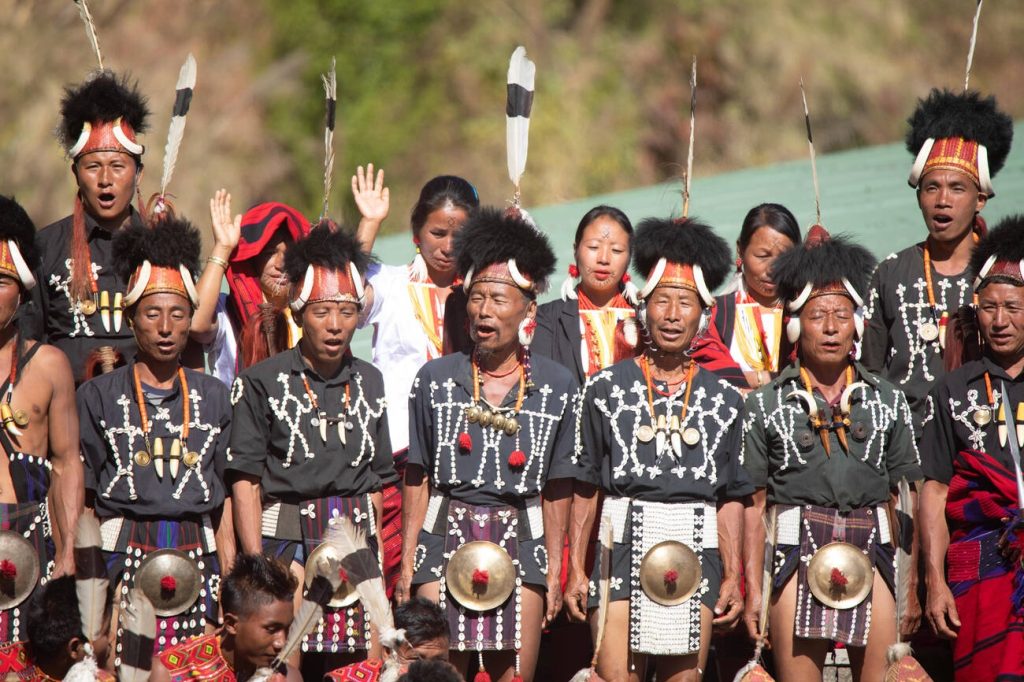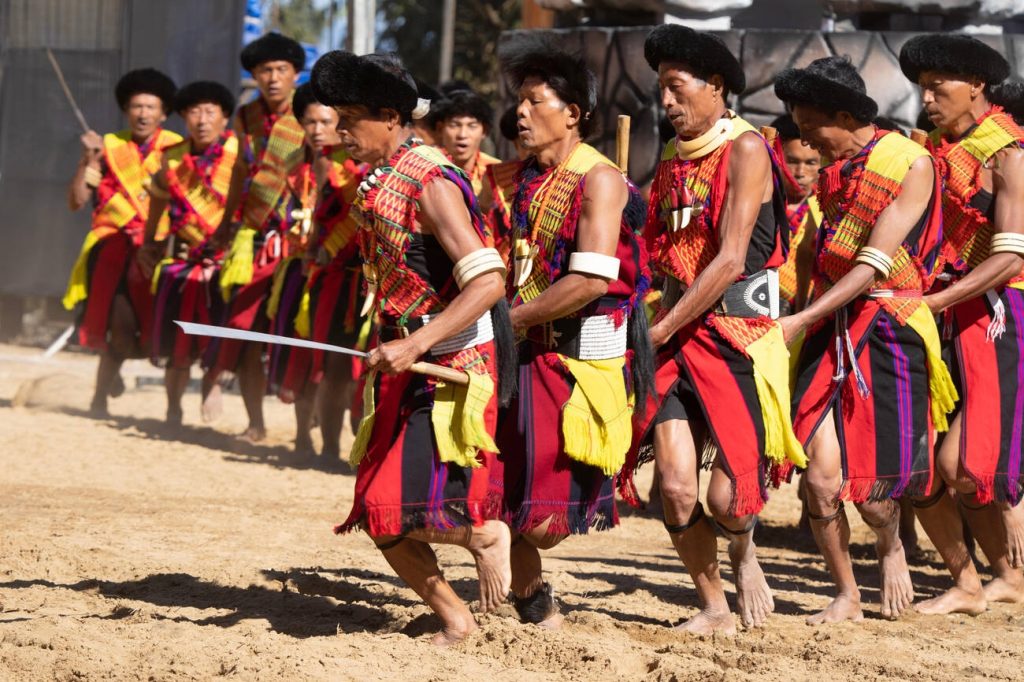Nagaland and its tribes are more than a mere tourist destination; they are a passage to an enchanting world where culture, tradition, and hospitality harmoniously blend. It’s an invitation to traverse the boundaries of ordinary travel and immerse oneself in a captivating narrative woven by the Nagas and their tribes. With every visit to this vibrant state, one takes a step deeper into the heart of Nagaland’s diverse culture, discovering new facets of an age-old yet ever-evolving story. Take a look at these nagaland tribes!
The 17 tribes of Nagaland-
Angami Tribe:

The Angami tribe, one of Nagaland’s prominent tribes, primarily inhabits the state’s hilly terrain. Known for their distinctive cultural identity, the Angamis are skilled in agriculture, particularly terrace farming. Their attire reflects their heritage, with men wearing shawls and women adorned in colorful woven skirts. The Angamis hold traditional beliefs and follow a patriarchal society, and their festivals, like Sekrenyi, revolve around agriculture and purification rituals. They have a strong sense of community and possess a rich oral tradition. The Angamis’ vibrant culture is a testament to the enduring traditions of Nagaland.
Related: 8 Fun Nagaland Festivals You Can’t Afford Missing!
Ao Tribe:

The Ao tribe, residing predominantly in Mokokchung, is renowned for its agricultural expertise. Aos are famous for their exquisite handwoven shawls, intricate beadwork, and skilled craftsmanship. Their traditional attire and adornments signify their distinct cultural heritage. The Ao community is predominantly Christian, and their religious festivals are deeply rooted in their cultural practices. The Moatsu festival, celebrated with great enthusiasm, is a testament to the Ao tribe’s vibrant cultural traditions.
Chakhesang Tribe:

The Chakhesang tribe is another integral part of Nagaland’s diverse tapestry. Occupying the Phek district, the Chakhesangs are known for their rich oral traditions, songs, and folklore. Their cultural practices are deeply ingrained in agriculture and hunting. The tribe celebrates many festivals, with the Tsukhenyie festival being a prominent event. Traditional attire and colorful accessories are essential elements of Chakhesang culture, reflecting the tribe’s unique identity and rich heritage.
Chang Tribe:

The Chang tribe, residing primarily in the Tuensang district, has a distinct cultural identity characterized by their traditional attire and agricultural practices. The Changs are skilled artisans, creating beautiful handwoven shawls and artistic beadwork. Agriculture plays a pivotal role in their lives, and they celebrate various festivals to honor nature and their deities. Among these festivals, Naknyülüm and Metumni are notable. The Chang tribe’s strong sense of community and reverence for their traditions are evident in their vibrant culture and rituals.
Konyak Tribe:

The Konyak tribe is one of the most iconic Naga tribes, known for their distinctive culture and fierce warrior traditions. Residing primarily in the Mon district, the Konyaks are famous for their headhunting history, which has now transformed into a unique cultural practice. They are skilled artisans, crafting intricate wood carvings, traditional weaponry, and colorful beadwork.
The Konyaks have a deep-rooted sense of spirituality and follow animistic beliefs. A major highlight of their culture is the Aoling festival, a grand celebration of agriculture and spirituality. The Konyak attire, adorned with beads and animal fur, is a visual representation of their rich heritage. This tribe’s unique cultural elements have made them a subject of fascination and study for many.
Kheimungan Tribe:
The Kheimungan tribe, a lesser-known but integral part of Nagaland’s cultural diversity, primarily resides in the Kiphire district. Their culture is deeply intertwined with nature and agriculture. The Kheimungans are skilled in making bamboo and cane products, and their traditional attire showcases a blend of intricate beadwork and locally sourced materials. Their festivals, such as Yemshe, are celebrated with enthusiasm and involve rituals to appease the deities and ensure a bountiful harvest. The Kheimungans’ cultural practices reflect a harmonious relationship with their surroundings and a strong sense of community, adding to the vibrant tapestry of Nagaland’s tribes.
Kachari Tribe:

The Kachari tribe, predominantly found in the Dimapur and Karbi Anglong districts, contributes to the cultural mosaic of Nagaland. They have a unique identity characterized by their traditional attire, which includes handwoven garments adorned with vibrant colors and intricate patterns. The Kachari people have a deep connection to their agricultural roots and celebrate various festivals that revolve around farming, like Bwisagu. Their dance forms, accompanied by melodious tunes, are a prominent feature of their culture. The Kacharis have maintained their distinct cultural heritage, enriching Nagaland’s diversity with their unique traditions.
Kuki Tribe:

The Kuki tribe is a diverse group with members scattered across Northeast India, including Nagaland. They are known for their vibrant cultural practices and a rich oral tradition that has been passed down through generations. The Kukis have a deep connection to their agricultural heritage, and their festivals, like Chavang Kut, reflect their reverence for nature. Their traditional attire features colorful textiles and intricate beadwork. The Kukis’ diverse and widespread presence adds a multifaceted layer to the cultural landscape of Nagaland, emphasizing the region’s remarkable cultural diversity and the resilience of its tribal traditions.
Lotha Tribe:

The Lotha tribe, primarily found in the Wokha district of Nagaland, is an integral part of the state’s diverse cultural landscape. They are renowned for their vibrant traditions and rich oral folklore. Agriculture forms the backbone of their livelihood, and the Tokhu Emong festival is a significant celebration that reflects their deep connection to the land. Lothas are skilled artisans, creating exquisite handwoven shawls and ornate beadwork. Their traditional attire is a striking blend of colors and intricate designs, symbolizing their unique cultural identity. The Lothas’ strong sense of community and their commitment to preserving their heritage have made them an essential component of Nagaland’s cultural mosaic.
Phom Tribe:

The Phom tribe, predominantly residing in the Longleng district, boasts a culture deeply rooted in agriculture. They are known for their unique customs and vibrant festivals like Monyu. The Phoms have a strong affinity for weaving and are skilled in crafting intricate designs on their traditional attire, including shawls and accessories. Their cultural practices revolve around their close connection to nature and their deities. The Phom tribe’s unique identity is exemplified through their traditions and rituals, making them an indispensable part of Nagaland’s cultural diversity.
Pochury Tribe:

The Pochury tribe, residing primarily in the Phek district, is an essential component of Nagaland’s cultural tapestry. Their way of life is closely tied to agriculture, and they celebrate their deep connection to the land through the Yemshe festival. The Pochurys are known for their exquisite handwoven shawls and traditional attire, adorned with intricate beadwork. Their culture is steeped in traditional rituals, and their reverence for nature is evident in their customs. The Pochury tribe’s cultural heritage is a testament to their unique identity and the enduring traditions that have been passed down through generations.
Also read Traditional Elegance: The Timeless Beauty of Nagaland Dresses!
Rengma Tribe:

The Rengma tribe, primarily found in the Mokokchung and Tuensang districts, is an integral part of Nagaland’s cultural diversity. Known for their vibrant traditions, the Rengmas have a strong connection to agriculture, which is celebrated in festivals like Ngada. Their traditional attire, characterized by colorful shawls and intricate beadwork, is a visual representation of their rich cultural heritage. The Rengmas follow a patriarchal society and maintain a deep sense of community. Their culture is a fusion of tradition and spirituality, contributing significantly to the diverse tapestry of Nagaland’s tribes.
Sumi Tribe:

The Sumi tribe, predominantly residing in the Zunheboto district, is a vibrant and prominent part of Nagaland’s cultural mosaic. Agriculture plays a central role in their lives, and the Tuluni festival is a grand celebration of the harvest. The Sumis are known for their striking traditional attire, featuring intricately designed shawls and ornate beadwork. They have a rich oral tradition, passing down their customs and folklore through generations. The Sumi tribe’s culture is marked by a deep connection to nature, a strong sense of community, and an enduring commitment to preserving their unique heritage, making them an essential part of Nagaland’s diverse tribal identity.
Sangtam Tribe:
The Sangtam tribe, predominantly residing in the Tuensang district of Nagaland, is a unique cultural entity that enriches the state’s diverse heritage. They have a strong connection to agriculture, and their cultural practices revolve around the land and its bounty, celebrated in festivals like Tsükhenyie. The Sangtams are skilled artisans, known for their traditional attire featuring intricate designs and beadwork. Their cultural identity is characterized by vibrant colors and a deep respect for their ancestral traditions. The Sangtam tribe’s folklore, rituals, and customs are integral to Nagaland’s rich cultural mosaic, providing a glimpse into a world where tradition and spirituality harmoniously coexist.
Tikhir Tribe:
The Tikhir tribe, primarily found in the Tuensang district, is a cultural gem of Nagaland. They have a deep-rooted connection to nature and celebrate their bond with the land in festivals like Tikhir. The Tikhir people are known for their traditional attire, which showcases colorful shawls and ornate beadwork. Their culture revolves around agriculture and hunting, and their customs and rituals reflect their close relationship with the natural world. The Tikhir tribe’s unique cultural elements contribute to the rich tapestry of traditions that define Nagaland’s diverse heritage.
Yimkhiung Tribe:
The Yimkhiung tribe, predominantly residing in the Tuensang district, is an integral part of Nagaland’s cultural diversity. Their way of life is closely tied to agriculture, and they celebrate their connection to the land through festivals like Metumni. The Yimkhiungs are known for their traditional attire, adorned with vibrant colors and intricate beadwork, which symbolizes their unique cultural identity. Their customs and rituals are a testament to their deep reverence for nature and their deities. The Yimkhiung tribe’s cultural heritage adds a distinctive layer to Nagaland’s diverse cultural tapestry, highlighting the endurance of their traditions.
Zeliang Tribe:
The Zeliang tribe, predominantly residing in the Peren district of Nagaland, is a cultural treasure. Their way of life revolves around agriculture and hunting, celebrated in festivals like Moatsu and Tsüngremong. The Zeliangs are known for their traditional attire, featuring vibrant shawls and intricate beadwork, which signify their unique cultural identity. Their customs and rituals reflect their strong connection to nature and their deep-rooted spirituality. The Zeliang tribe’s culture is a captivating blend of tradition and spirituality, contributing significantly to the diverse tapestry of Nagaland’s tribes.
Thus, Nagaland stands as an extraordinary testament to India’s remarkable cultural diversity. The 17 major tribes and numerous sub-tribes that call this hilly state home paint a vivid portrait of heritage, tradition, and spirituality. Each tribe, from the Angamis to the Zeliangs, weaves its unique thread into the intricate tapestry of Nagaland’s cultural identity.
From their striking traditional attire to the deep connection with agriculture and nature, these tribes offer a captivating glimpse into a world where the old and the new harmoniously coexist. Nagaland’s tribes are not just chapters in history; they are living, breathing embodiments of tradition, sharing their warmth, hospitality, and vibrant traditions with those who venture into this enchanting corner of India. Exploring Nagaland is not just a journey; it’s an immersion into the heart of its diverse and enduring culture, a treasure trove of stories waiting to be discovered.
FAQs
How many total tribes are there in Nagaland?
Nagaland is home to 17 major tribes, each with its distinct culture and traditions.
What is the main tribe of Nagaland?
The largest and most prominent tribe in Nagaland is the Angami tribe, known for their unique customs and language.
Which is the most famous tribe in Nagaland?
The Naga tribe, as a collective term, is the most well-known in Nagaland due to their history and the Naga insurgency movement.
What is a female Naga called?
A female Naga is commonly referred to as a “Naga woman” or “Naga lady.”
What is the oldest tribe of Nagaland?
The Konyak tribe is one of the oldest and most ancient tribes in Nagaland, with a rich cultural heritage and unique practices.



